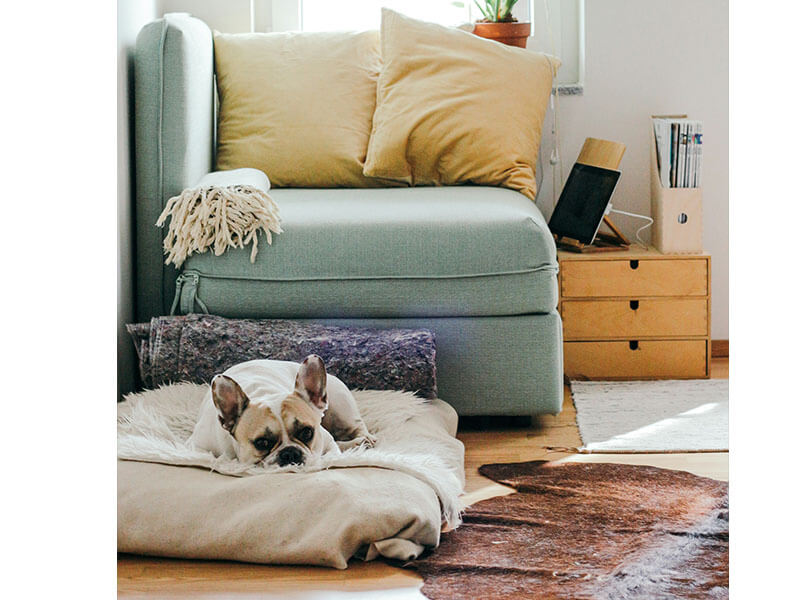The number of registered
animals is growing every day
Published: Oct 17, 2024

Does your dog scratch at the door when you leave him alone at home? Maybe he howls and barks when he sees you leaving without him, or chews on your shoes in your absence? As a social and pack animal, a dog definitely feels more comfortable in the company of people he is attached to. For this reason, he never feels fully comfortable when he has to stay alone for a few hours. However, there is a difference between natural discomfort and a mental issue that makes it difficult for the dog to function daily and can lead to many undesirable situations. Separation anxiety dogs - what is it? Where does it come from? How does it manifest, and how can you deal with it?
How does separation anxiety manifest in dogs? There are many ways this mental state can be expressed by animals. Some dogs experience it more intensely, while others less so. Depending on the character, temperament, and previous socialization, the dog may chew on shoes, urinate on furniture, run around the house, make various sounds, or scratch at the doors.
Separation anxiety in dogs can also manifest in a completely different way. The animal becomes apathetic, refuses to eat, can't sleep, and stays in a secluded spot, making quiet, barely noticeable sounds.
To summarize, the most common signs that should worry you include:
Your dog may also try to chase after you and follow you. In a moment of anxiety, he may try to escape outside, dig under the fence, or jump over it to follow his guardian. In a rush of fear and panic, a sudden adrenaline surge may cause the dog to try to overcome obstacles at any cost, which can lead to problems returning home.
Just in case, ensure your dog has a microchip, and don't forget that the only way for the chip to work is by registering your dog. Only a chipped dog, whose data, along with the owner's information, is stored in the Central Dog Register, such as WORLDPETNET, has a chance to be quickly found and notify the owner about where their dog is waiting for pickup.

If from the beginning, you let your dog sleep in your bed, he may later have trouble with isolation, even during the day. Separation anxiety at nightoccurs in dogs that cannot relax properly, stay in a separate room, or do not have their own designated sleeping space. Your companion needs to know he has a spot just for him.
Separation anxiety in rescue dogs is often related to their emotional state and traumatic past. Dogs that feel insecure may fear the loss of the "pack" they created through adoption. As a result, they want to stay with their guardian at all costs because their absence reminds them of a loss they don't want to experience again.
If you, as the dog's owner, are his whole world and provide positive stimuli that he couldn't rely on before, there is a high probability that separation anxiety will develop, which you will have to work through together with your pet.
How can you help a dog with separation anxiety? The best way to prevent your dog from suffering from psychological issues related to separation anxiety is consistent socialization and gradually preparing him for your absence. However, if it's too late for that, help your dog deal with his fears step by step.
You should start with exercises that help the dog get used to the new situation and reassure him that nothing bad is happening.

It is possible to overcome separation anxiety in dogs. However, you need to be patient, consider the individual dog's predisposition to being left alone, and try to understand his emotions to better manage them and respond accordingly. Unfortunately, it may not be possible to change every dog's behavior on your own. If you don't see progress, ask for help from a dog behaviorist.
A dog with separation anxiety may attempt to run away in search of its owner. Microchippingand registering the dog in a database, such as WORLDPETNET, allow for quick identification and contact with the owner in case the dog goes missing, increasing the chances of its safe return home.



Marking animals with a microchip is the most durable, effective and completely safe method of quick and reliable identification. Every transponder (chip) has a unique number which enables instant identification of the animal and its owner, helping them reunite faster. However, it is important to remember that a chip is just a transponder with an encoded number. It is not a tracking device and contains no data about the animal or the owner! Therefore, in order to identify a chipped dog or cat, it is necessary that a microchip be registered in a national marked animal database...
Read moreIn today's world, responsibility for animal care has become not only a priority for their owners but also a societal issue. One of the most important tools in ensuring animal safety is the chip database. It allows for the quick and efficient recovery of lost pets, which is crucial for protecting their health and well-being.
The introduction of microchipping has significantly improved the effectiveness of efforts to locate lost animals, reducing stress for both owners and their four-legged friends. Registration in the chip database is increasingly required by local regulations, further highlighting the importance of this technology in ensuring comprehensive care for animals.